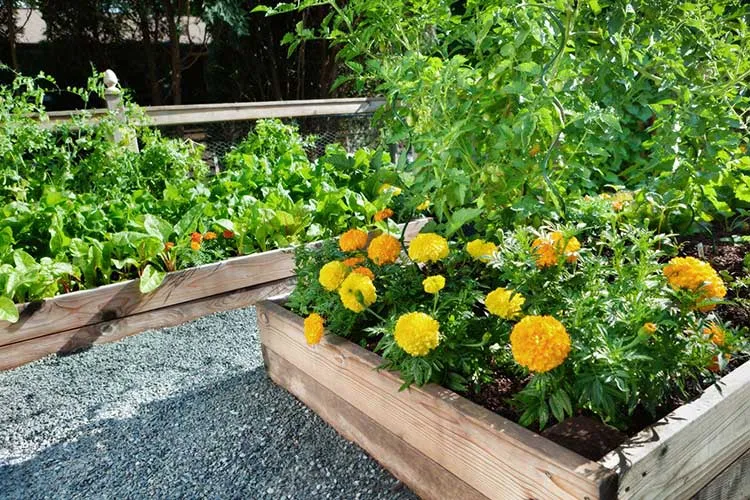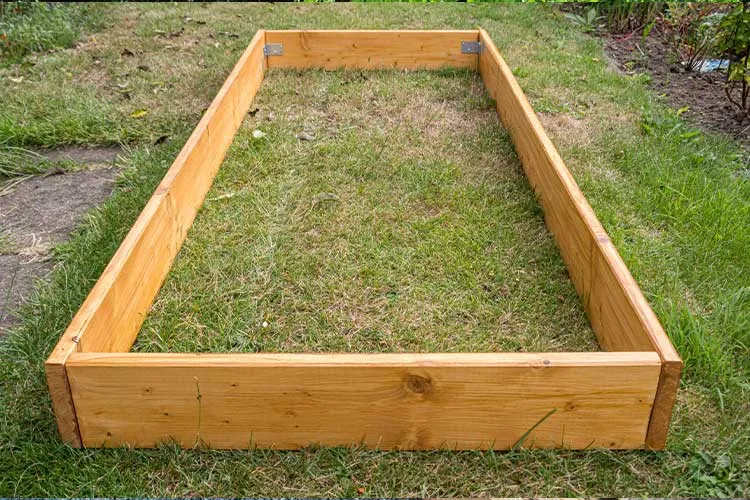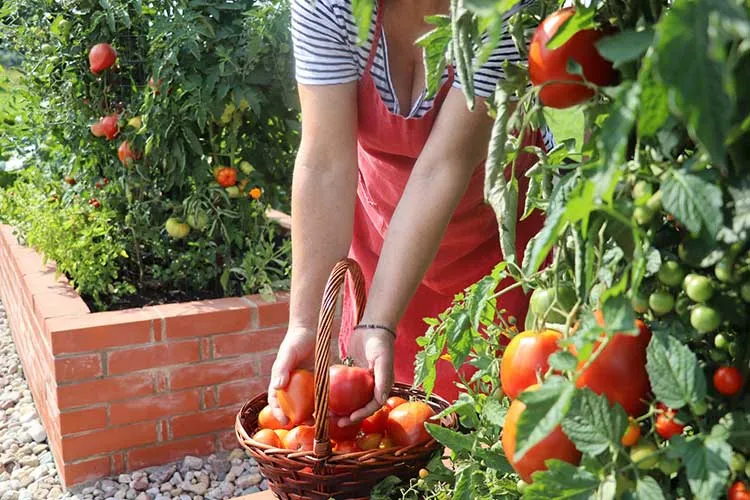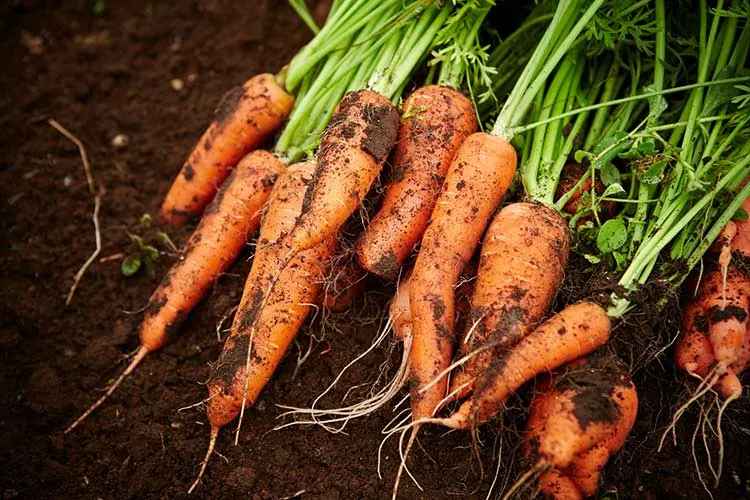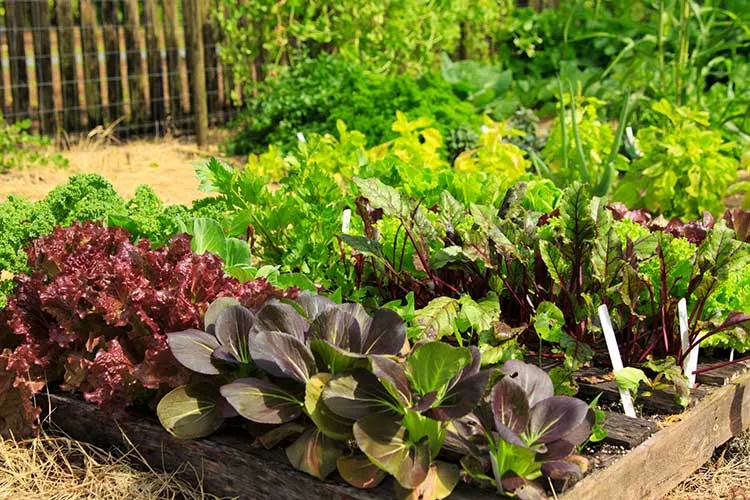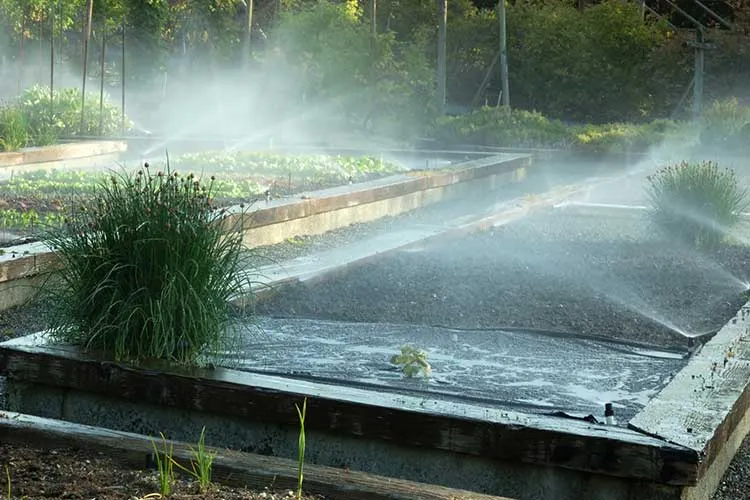If you’re new to growing lettuce or looking for a few more options to add to your garden, this guide on lettuce varieties is just what you need! From tender butterhead to crisp romaine and vibrant loose-leaf types, choosing the right varieties can elevate your garden and your meals.
This post breaks down must-know growing tips and highlights beginner-friendly options to help you cultivate lush, flavorful greens with ease. Whether you’re aiming for a fresh salad mix or sandwich toppers, you’ll discover the perfect varieties to suit your needs.
Lettuce Growing Basics: What You Should Know
Lettuce is a cool-season crop that thrives when temperatures moderate, making it an ideal choice for early spring and fall gardens. There are four main types of lettuce: Loose Leaf, Romaine, Butterhead, and Crisphead. Each has unique textures and flavors, but all are relatively easy to grow when given the right conditions.
Loose-leaf varieties grow in open clusters rather than forming heads, making them perfect for gardeners who want to harvest leaves over time. Romaine produces tall, crisp heads with a sturdy midrib, making it the go-to choice for classic Caesar salads. Butterhead lettuces, like Buttercrunch, form loose, tender heads with smooth, velvety leaves and a mild, sweet flavor. Lastly, Crisphead lettuces, including iceberg types, develop tight, crunchy heads and need cooler weather to form properly.
Key Growing Requirements
To grow well, lettuce needs nutrient-rich, loose soil. Aim for light soil that drains easily but retains enough moisture to keep roots happy. Adding compost before planting can give your lettuce the boost it needs for lush, leafy growth.
Sunlight is important, but lettuce prefers filtered light or partial shade, especially during warmer months. Too much direct sun in hot weather can cause the plants to “bolt” or go to seed, which makes the leaves bitter. Your lettuce patch should get at least 4–6 hours of sun daily.
Consistent watering is crucial to prevent leaves from becoming dry or bitter. A steady moisture supply keeps the plants cool and productive but avoids drenching them to waterlogging the roots. Try to water deeply about two to three times weekly, adjusting for rainfall and heat.
Spacing is another key factor. Crowding can lead to smaller heads and promote disease. Depending on the variety, most varieties do best, with 6–18 inches between plants so they have enough room to spread out. With some planning and care, your lettuce garden will thrive and produce for weeks.
7 Must-Grow Lettuce Varieties for Gardeners
When growing your lettuce, variety is the spice of life! Whether you prefer tender, buttery leaves or a satisfying crunch, there’s a lettuce variety to suit every taste. Here’s a closer look at seven must-grow lettuce varieties and why they deserve a spot in your garden.
Parris Island Romaine (Romaine)
Parris Island Romaine is one of the most popular romaine varieties and a go-to for Caesar salads. Its signature upright, spoon-shaped leaves deliver a satisfying crunch. Named after Parris Island in South Carolina, this variety was developed for its resilience and delicious flavor. The leaves are often described as deep green with lighter ribs at the center, forming a dense yet loose head. The color deepens as the plant matures, and the midrib adds a juicy bite.
Parris Island is recognizable for its long, narrow leaves that grow 10–12 inches long. When fully mature, it forms an impressive upright head that can withstand heat well, although it does best in cooler weather. Because of its versatility and wide culinary use, it’s a staple in home gardens and grocery stores. Compared to more niche romaine varieties, Parris Island tends to be more affordable, making it a reliable garden addition for beginners and seasoned gardeners.
Care Tips:
Parris Island Romaine thrives in rich, well-drained soil and prefers full sun, though it can handle partial shade in hotter regions. Consistent watering is key—if the soil dries out too much, the leaves can become bitter. You can harvest individual outer leaves as they grow or wait until the full head forms for a larger yield.
Days to Maturity: 65–70 days
Average Weight Per Plant: 1.5–2 pounds
Buttercrunch (Butterhead)
Buttercrunch is a beloved variety in the butterhead family, known for its soft, almost velvety leaves and loose heads that form a rounded rosette. The leaves are bright green with a subtle shine, and the edges often curl inward, giving the heads a cozy, “wrapped” look. Its texture is rich and tender, often compared to a luxurious butter-like feel—hence the name. When you tear a leaf, it has a soft snap rather than a crisp crunch, making it perfect for wraps, sandwiches, and fresh salads.
Buttercrunch is slightly more expensive at markets due to its delicate nature and slower bolting than other lettuces. However, it’s considered one of the most rewarding growing varieties because of its sweet, mild flavor and high yields. This variety is often recommended for spring and fall planting, as it performs well in cooler temperatures.
Care Tips:
Buttercrunch prefers cooler weather and performs best in early spring and fall. Mulching around the base helps regulate soil temperature and retain moisture, keeping the heads tender and sweet. Harvest when the loose head forms but before the plant shows signs of bolting.
Days to Maturity: 55–60 days
Average Weight Per Plant: 1–1.5 pounds
Red Oakleaf (Loose Leaf)
Red Oakleaf is one of the most visually stunning lettuce varieties. Its deeply lobed, soft leaves resemble oak tree leaves. The leaves range in color from deep burgundy to a rich, reddish-green hue at the base, making them stand out in the garden and on the plate. The soft, delicate leaves have a mild, nutty flavor with a hint of sweetness. This variety is often featured in gourmet salad mixes and is highly valued for its unique appearance and texture.
Because of its eye-catching color and premium look, Red Oakleaf is often considered a higher-end lettuce, especially when found in farmers’ markets or specialty stores. However, it’s incredibly easy to grow, making it an excellent choice for gardeners who want something impressive without added difficulty.
Care Tips:
For the best results, plant Red Oakleaf in nutrient-rich, loose soil. Regular watering and good airflow help prevent disease. Harvest individual leaves early and often to encourage continued growth. Protect the plants from extreme heat, as it can cause them to bolt and develop a more bitter taste.
Days to Maturity: 45–55 days
Average Weight Per Plant: 0.75–1 pound
Crispino Iceberg (Crisphead)
Crispino is a modern iceberg variety that improves upon the classic idea of iceberg lettuce by enhancing its disease resistance and heat tolerance. Its large, round heads are packed with densely layered, pale green leaves that form a tightly wrapped ball with a smooth, crunchy bite. The outer leaves are a slightly deeper green, while the inner leaves are almost white and incredibly crisp.
Iceberg lettuce, like Crispino, is often considered the “workhorse” of lettuces. It’s affordable, widely recognized, and provides that familiar crunch found in classic wedge salads or as the foundation of a burger. Crispino is also more resistant to wilting, making it a great option for meals where the lettuce needs to hold its structure.
Care Tips:
Crispino needs plenty of sunlight and consistent watering to get firm, dense heads. Space plants 12–18 inches apart to allow the heads to grow without overcrowding. Harvest when the head feels firm and before the outer leaves begin to yellow.
Days to Maturity: 70–75 days
Average Weight Per Plant: 1.5–2 pounds
Lollo Rosso (Loose Leaf)
Lollo Rosso is one of the most decorative lettuces you can grow. Its frilly, curly leaves range from deep ruby red to a soft greenish base. Due to its dramatic coloring and texture, this variety is often called “designer lettuce.” It is a favorite in upscale restaurant salads. The flavor is mildly bitter with an earthy undertone, contrasting with sweeter greens.
Lollo Rosso’s frilly edges add incredible volume and texture to any salad, making a small handful look like much more. This variety is often pricier in stores due to its delicate leaves and the added care it takes to keep them fresh during transport. However, it’s an excellent choice for home gardens since it’s quick-growing and can be harvested frequently.
Care Tips:
Lollo Rosso prefers cooler temperatures but can tolerate moderate heat if well-watered and protected from harsh winds. Regular harvesting prevents the leaves from becoming too bitter and helps delay bolting. This variety is perfect for continuous harvesting—just pick the outer leaves and let the center grow.
Days to Maturity: 50–55 days
Average Weight Per Plant: 0.5–0.75 pounds
Little Gem (Mini Romaine)
Little Gem is a mini romaine variety often called the “best of both worlds” because it combines the sweet, crisp texture of romaine with the tender, compact size of butterhead lettuce. The heads are small—about 6–8 inches tall—and have bright green outer leaves with slightly paler, creamy centers. The leaves have a satisfying crunch, making Little Gem a popular choice for lettuce wraps and individual salads.
Due to its compact size and gourmet reputation, Little Gem is often sold at a premium, especially in specialty grocery stores. However, it’s perfect for home gardeners with limited space and is known for its high productivity in small areas or containers.
Care Tips:
Because of its compact size, Little Gem performs well in small gardens and pots. To prevent root rot, keep the soil consistently moist but avoid waterlogging. Harvest when the heads are firm but still small for the best flavor.
Days to Maturity: 55–60 days
Average Weight Per Plant: 0.75–1 pound
Tropicana (Summer Crisp)
Tropicana is a summer crisp lettuce that holds up to heat better than many other varieties. It forms large, loose heads with thick, bright green leaves with ruffled edges and a crisp, juicy bite. The flavor is mild and sweet, making it a refreshing option for summer salads. The thick leaves help it resist wilting, making Tropicana a popular choice for wraps and sandwiches.
Tropicana’s heat tolerance makes it a favorite for gardeners in warmer climates where more delicate varieties would bolt quickly. Despite its resilience, it remains tender and flavorful, rather than developing the bitterness that can plague some heat-tolerant lettuces.
Care Tips:
Tropicana thrives in warm climates and resists bolting better than many other varieties. To keep the leaves tender, provide partial shade during the hottest parts of the day and ensure regular watering. Mulching helps retain moisture and keep the soil cool.
With these detailed descriptions, you can choose the best lettuce varieties for your garden, whether you’re aiming for gourmet salads, hearty sandwich toppings, or summer-friendly greens. Up next: practical tips to keep your lettuce thriving even during the peak of summer heat.
Days to Maturity: 50–55 days
Average Weight Per Plant: 1–1.5 pounds
Best Ways to Protect Lettuce from Summer Heat
Growing lettuce is relatively low-maintenance, but keeping your plants happy during warmer weather requires extra care. Heat can cause lettuce to bolt, leading to bitter leaves, but with the right strategies, you can keep your greens thriving even in the heat of summer.
Provide Afternoon Shade
When temperatures rise, providing your lettuce with some relief from the hot afternoon sun can prevent bolting. Use shade cloth, row covers, or taller companions like tomatoes nearby to create natural shade without blocking too much light.
Mulch to Retain Soil Moisture
A layer of organic mulch, such as straw or shredded leaves, helps the soil retain moisture and stay cool. Mulching also suppresses weeds and prevents the roots from overheating, a key factor in keeping lettuce tender and productive.
Water Regularly
Lettuce needs consistent moisture, especially in the heat. Water deeply 2–3 times a week to ensure the soil stays damp but not waterlogged. Drip irrigation or soaker hoses are excellent options for delivering even hydration directly to the roots without wetting the leaves, which can lead to fungal issues.
Choose Heat-Tolerant Varieties
Some lettuce varieties, like Summer Crisp (Tropicana) or Romaine (Little Gem), naturally resist bolting and bitterness during warmer weather. Incorporating these heat-tolerant types into your garden helps extend your growing season and reduces the stress of high temperatures.
Harvest Outer Leaves Frequently
For leaf varieties, harvesting outer leaves regularly encourages continuous growth and prevents the plant from shifting energy into producing seeds. This also keeps your plants from getting leggy and overcrowded.
Avoid Over-Fertilizing
While lettuce appreciates nutrient-rich soil, too much fertilizer, especially nitrogen, can cause rapid growth and taste bitter. Use compost or a balanced organic fertilizer and avoid overdoing it.

